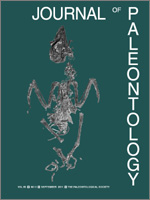Morphologic analyses of a large quantity of teudopseid coleoids from the Upper Cretaceous (Cenomanian) of Lebanon has yielded a much higher diversity than previously assumed and revealed numerous extraordinarily well-preserved soft-part characters. The Teudopseina is represented by three families (only the Muensterellidae are still unknown in the Lebanon Plattenkalks). The Teudopsidae is represented by one species (Teudopsinia haasi), the Trachyteuthididae by five species (Trachyteuthis bacchiai n. sp., Glyphiteuthis libanotica, Gl. abisaadiorum, Gl. freijii n. sp., and Glyphidopsis waagei n. gen. n. sp.), and the Palaeololiginidae by one species (Rachiteuthis donovani). Gl. freijii n. sp. represents the first record of a coleoid cephalopod from Nâmmoura. A detailed comparison with Jurassic gladii shows that the Teudopseina is a very homogenous group that can be easily differentiated from other Mesozoic, gladius-bearing groups (Prototeuthidina, Loligosepiina). Despite comparatively large gaps in the fossil record, each of the Late Cretaceous gladii can be readily associated with Jurassic precursors. Particularly, the first record of two pairs of fins in Glyphiteuthis exemplifies that in addition to gladius similarities, similarities in soft-parts exist as well. A previously undescribed specimen of Rachiteuthis exhibits unusually well-preserved gills. In general, the soft-part morphology of the Teudopseina clearly indicates octobrachiate affinities (i.e., absence of tentacles, circular suckers, cirri, two pairs of fins, octopod-like eye capsules); no existing evidence supports a decabrachiate relationship.
How to translate text using browser tools
1 September 2011
Diversity, Morphology, and Phylogeny of Coleoid Cephalopods from the Upper Cretaceous Plattenkalks of Lebanon–Part II: Teudopseina
Dirk Fuchs,
Neal Larson
ACCESS THE FULL ARTICLE

Journal of Paleontology
Vol. 85 • No. 5
September 2011
Vol. 85 • No. 5
September 2011




